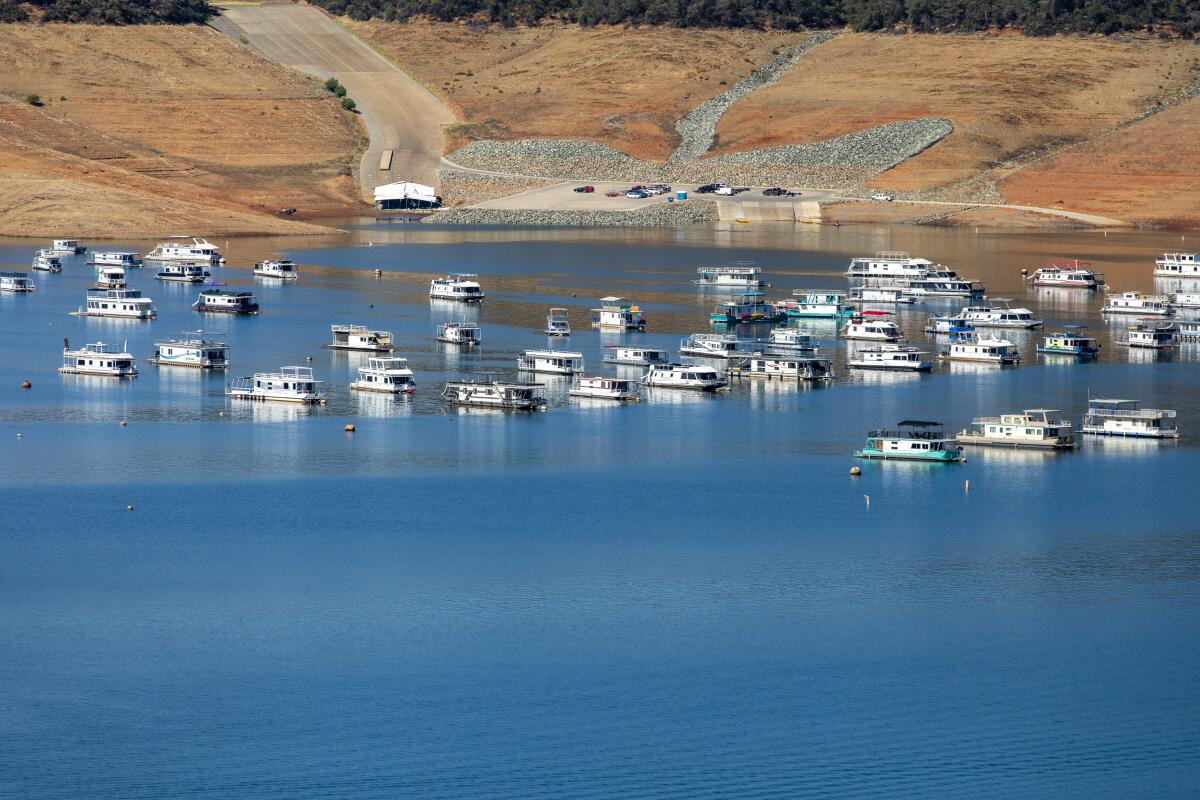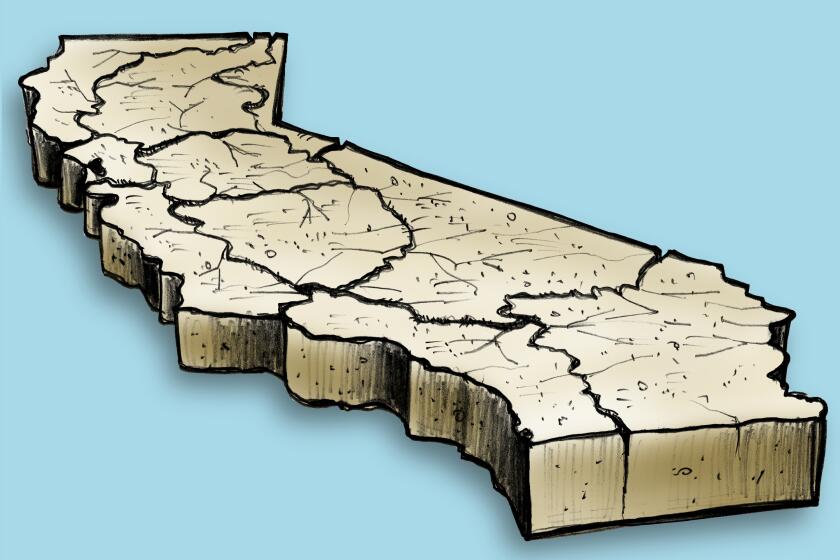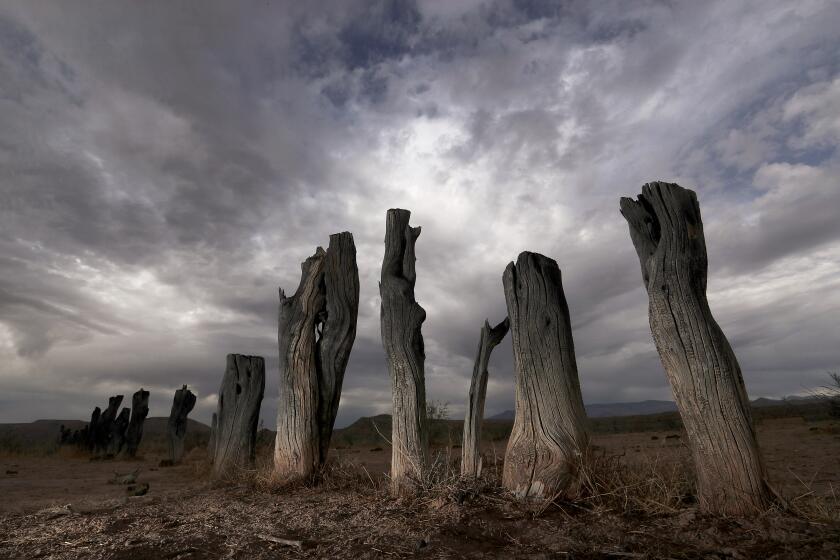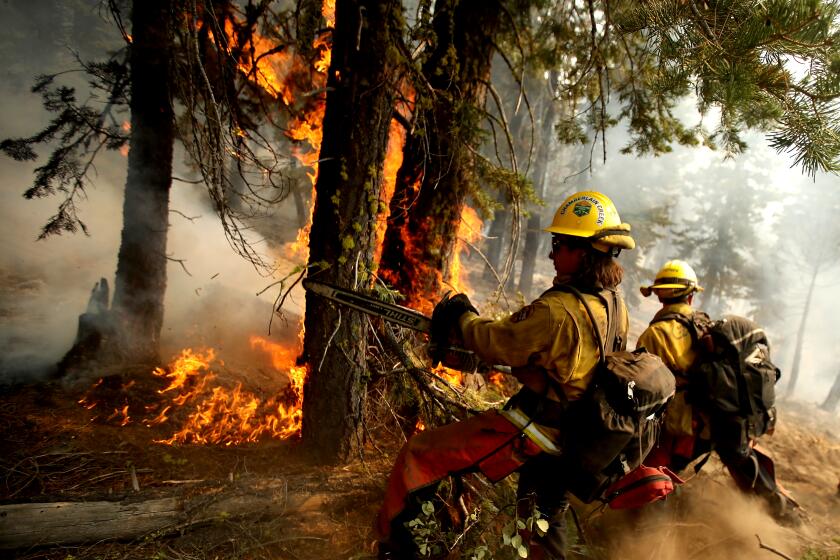California should expect a ‘fourth dry year’ as drought persists

- Share via
California’s reservoirs will enter fall in a slightly better position than last year, but the Golden State should prepare for more dryness, extreme weather events and water quality hazards in 2023, officials say.
The latest climate forecasting update from the Department of Water Resources came Wednesday, just days before the end of the water year, which runs from Oct. 1 to Sept. 30 in California. Officials said some of the state’s biggest reservoirs, including Lake Oroville and Lake Shasta, are slightly more full than they were at the same time last year, but still remain well below average.
Water managers are now preparing for a “fourth dry year,” as well as more unpredictable weather and wildfires associated with climate change, DWR Assistant Deputy Director John Yarbrough said during a meeting of the California Water Commission.
“We have more storage in the reservoirs, but we’re still well below average, well below where we’d like to be,” Yarbrough said. What’s more, “we have to prepare and expect that we’re going to see things that we haven’t seen before.”
The latest maps and charts on the California drought, including water usage, conservation and reservoir levels.
Part of the challenge facing the state’s water managers is that climate change is making it more difficult to predict and prepare for water outcomes, Yarbrough said. During the 2022 water year, officials observed significant swings between extreme wet and extreme dry conditions, including a notably rainy October through December followed by the driest January through March on record.
Yarbrough said such variability underscores the need for conservative planning and aggressive multiagency action.
“When we look at patterns like this, it really challenges a lot of our practices for how we plan the system, for how we’re going to operate for the next year,” he said.
The 2022 water year also saw warmer-than-normal temperatures and drier-than-normal conditions, he said, but both metrics were slightly improved from the year prior. Lake Shasta, the state’s largest reservoir, is projected to end the water year with 1.48 million acre-feet in storage — up from 1.07 million acre-feet last year.
Still, Yarbrough emphasized that California remains in serious drought. Even with improved storage, Shasta sits at about 34% of its capacity, according to The Times’ drought tracker.
It’s “better than last year but not good enough,” he said.
The West is experiencing its most severe megadrought in a millennium, according to a new study. Scientists say climate change is playing a major role.
Though California has experienced periods of drought in the past, Wednesday’s report came against a backdrop of significant water cuts and worsening aridity in what researchers have described as the driest 22-year period in at least 1,200 years.
What’s more, the state’s other primary water supply — the Colorado River — is also running perilously low, with federal officials warning that another 150-foot drop in Lake Mead could lead to “dead pool” conditions, or the point at which water falls below the lowest intake valve on the Hoover Dam.
The looming crisis has put the pressure on California and other nearby states to figure out how to significantly reduce their reliance on the river, and officials have said painful cuts are likely in the coming months.
But climate change isn’t only affecting water availability in California — it is also affecting the quality of water, especially in watersheds near wildfires, according to Andrew Schwarz, climate action coordinator with the State Water Project.
More than half of the Feather River Watershed — the largest in the Sierra Nevada — burned in wildfires between 2019 and 2021, Schwarz said. About a quarter of it burned at high intensity levels associated with significant tree mortality.
Such fire activity can have myriad effects on the watershed, including altered soil and vegetation. Schwarz said black carbon deposits from ash and burned trees can change the reflectivity of snow to make it melt faster, while high heat can make soil waxy, more water repellent and more prone to runoff. What’s more, erosion and debris flow can send sediment into rivers and other sources of water.
“It’s an incredible change in the landscape of a watershed, as you can imagine,” he told the California Water Commission.
Wildfires are increasing streamflow throughout the western U.S., raising new threats for public safety and water management, according to researchers.
That confluence of hazards means the state’s water managers are increasingly accounting for wildfires in their climate resilience efforts, Schwarz said, including improving water safety plans for local residents and implementing new sensor data to help experts monitor changing hydrology.
“We’ll probably have more fire in the watershed, and so we’ll be able to continue to adapt to this and get better information as we go along,” he said.
Commissioner Alexandre Makler said the reports underscored the need for continued maintenance and asset management on the State Water Project.
“It needs to be in tip-top shape — that’s absolutely critical,” he said, adding that “it’s clear that there is a significant capital component in addressing the risk, and combining that with the planning process.”
California has been investing in such work, with the 2022-2023 state budget carving out $1.2 billion in new funds to lessen wildfire risk through better forest management and $2.8 billion to support drought resilience and response, among other items.
But the mounting challenges mean there is much work yet to be done. Other water priorities for the coming year include maintaining the quality of the Sacramento-San Joaquin Delta, which is the source of municipal drinking water for many communities, while continuing to meet minimum health and safety needs and protecting species and the environment, Yarbrough told the commission.
It’s also critical to conserve as much reservoir water as possible, he said, “so we have water again in case we’re faced with a fifth dry year.”
More to Read
Sign up for Essential California
The most important California stories and recommendations in your inbox every morning.
You may occasionally receive promotional content from the Los Angeles Times.














